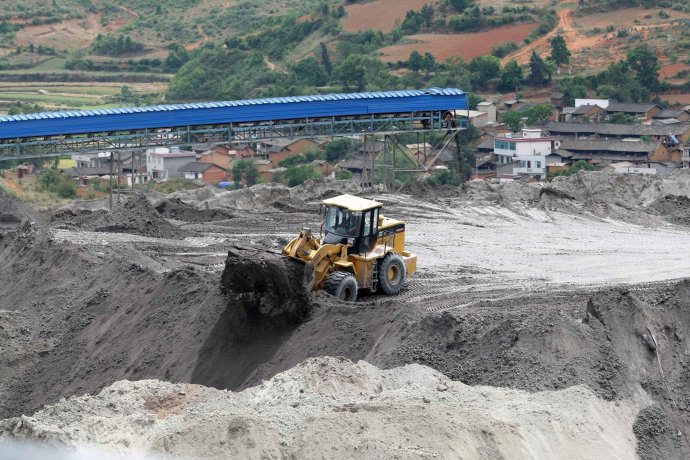On 3 Oct., 2016, Professor Sun Zhenping and
his research team, from Tongji University, published a report concerning the
status quo of domestic phosphogypsum application. Given the rapid development
of the phosphate fertiliser business and the explosive growth in production of
phosphogypsum in China, he highlighted a problem of great urgency: that is, how
to improve the comprehensive utilisation rate of phosphogypsum.

Source: Baidu
Domestic production of phosphogypsum now reaches about 50 million tonnes per
year, and cumulative stockpiling so far has surpassed 200 million tonnes,
according to the report. However, underdeveloped utilisation technology is
restricting utilisation, which is now at about 10 million tonnes per year:
-
For building purpose gypsum plaster: about
2.80 million tonnes per year
-
For cement retarder: about 2.50 million tonnes
per year
-
For gypsum block and gypsum brick: about
1.60 million tonnes per year
-
For filling materials: about 1.50 million
tonnes per year
-
For soil amendment: about 1.50 million
tonnes per year
-
For chemicals such as sulphuric acid and
ammonium sulphate: about 100 thousand tonnes per year
Specifically, 4 key problems revealed
during the comprehensive utilisation of phosphogypsum in China are listed in
the report:
1. Huge costs due to high content of impurities:
Acidic substances in
phosphogypsum, such as free phosphoric acid and sulphuric acid, result in low
pH value and can easily cause corrosion of production equipment; phosphates and
fluorochemicals also contained in phosphogypsum have a negative impact on post
processed products, which means that phosphogypsum should be purified first
before further utilisation; secondary pollution is generated during the
utilisation of phosphogypsum for which equipment for environmental treatment
should be installed, further adding to costs.
2. Imbalanced regional development and overall low utilisation level:
Production,
stockpiling and utilisation of phosphogypsum vary regionally, impacted by
resource distribution and transportation conditions. Mainly its production and stockpiling are centred in phosphate
fertiliser producing areas (say Yunnan, Guizhou, Sichuan, Hubei and Anhui
provinces), and consumption is concentrated in building purpose gypsum and
cement producing areas such as the economically developed eastern region.
Limited by transportation conditions, supplies of phosphogypsum in large
consuming areas are short whilst areas with high production can only have
phosphogypsum piled up.

3. Incomplete standards:
China lacks segmented standards for phosphogypsum used for different building
materials, which is not beneficial to its application; besides, the
comprehensive utilisation of phosphogypsum is based on standards for other
gypsums due to a shortage of standards specifically for phosphogypsum – this
receives low market recognition.
4. Utilisation restricted by natural gypsum which is under large production:
China’s output of natural gypsum was 45 million tonnes in 2010, mainly in
Shandong, Hunan, Hubei, Jiangsu and Anhui provinces. The large exploitation of
natural gypsum, in addition to damaging natural environment, is also a factor
in setting off the use of industrial byproduct phosphogypsum. Currently,
domestic comprehensive utilisation rate of phosphogypsum is 20%, vs. 35% in the
US and nearly 100% in Japan.
Professor Sun believes that the post
treatment of phosphogypsum now has become a “bottleneck” impacting development
of the domestic phosphorus chemical industry, “The key is to improve the
comprehensive utilisation of phosphogypsum, and the most flexible way currently
is to use it to produce cement retarder, gypsum block, gypsum brick and gypsum
plasterboard.”
In the report, he also calls for the perfection of standards for comprehensive
utilisation and application of phosphogypsum in industry, and the acceleration
of the formulation and revision of standards on phosphogypsum and related
products, “Government policies still play a crucial role in increasing the
comprehensive utilisation of phosphogypsum. Policies involving taxation,
energy, etc., should be issued to support enterprises, so as to enable them to
make profit or break even during this utilisation. Probably value added tax
could be exempted for building materials and chemicals based on phosphogypsum.”
This article comes from Phosphorus Industry China Monthly Report 1610, CCM

About CCM:
CCM is the leading market intelligence provider for China’s
agriculture, chemicals, food & ingredients and life science markets. Founded in 2001, CCM offers a
range of data and content solutions, from price and trade data to industry
newsletters and customized market research reports. Our clients include Monsanto,
DuPont, Shell, Bayer, and Syngenta. CCM is a brand of Kcomber Inc.
For more
information about CCM, please visit www.cnchemicals.com or get in touch with us
directly by emailing econtact@cnchemicals.com or calling
+86-20-37616606.
Tag: phosphorus phosphogypsum